Environmental Microbiome
-
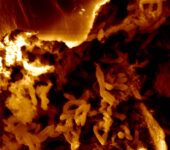
Clostridium on Switchgrass
Scanning electron micrograph of Clostridium cellulolyticum cells growing on switchgrass. Isolated from decaying grass compost, C. cellololyticum degrades cellulosic biomass using multienzyme complexes called cellulosomes.
-
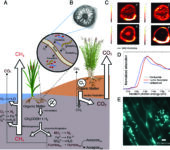
Coupled Biogeochemical Cycles
(a) Routes of carbon turnover in anoxic and oxic interface zones. Arrows with gas flux to the atmosphere represent potential emission routes. (b) Optical microscopy cross-section image of wetland plant aerenchyma. (c) Corresponding X-ray fluorescence image of nutrient elemental distributions within aerenchyma cross section in b. (d) Spatially resolved (25-micrometer resolution) iron X-ray absorption spectroscopy measurements of iron valence state in rhizoplane of wetland plant aerenchyma [red Fe(III)] and surrounding sediment [blue Fe(II)]. (e) Confocal microscopy image of cytoplasmic fluorescence-labeled rhizobacteria (Pseudomonas fluorescens SBW25) colonizing plant root cells.
-
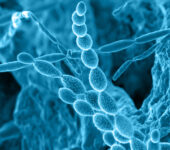
Microbes in Pine Rhizosphere
Soils are vital to our future supply of water and food, but they also play a critical role in adapting to climate change and sustaining the planet’s biosphere—the land, sea and atmosphere occupied by living things. With funding from the Laboratory Directed Research and Development program, Pacific Northwest National Laboratory researchers studied microbes from the typical rhizosphere found in the Northwest’s Central Cascades pine forests to better understand how microbes help stabilize carbon in soils. The rhizosphere is the small area surrounding plant roots where microbes interact with minerals in the soil—a hot spot for biogeochemical activity that is constantly changing. Microbes in the rhizosphere play a very important role in soil processes like mineral weathering and the transformation of soil organic matter.
Research Team: Alice Dohnalkova, Rosey Chu, Malak Tfaily, Alex Crump, Tamas Varga, Colin Brislawn and William Chrisler (PNNL).
This image was captured with the Helium Ion microscope in EMSL, the Environmental Molecular Sciences Laboratory, a DOE national user facility at PNNL.
-

Plant Scientists in Laboratory
Crosscutting and Multiscale Approach. Biodesign lies at the core of the Genomic Science Program’s three primary research focus areas: Bioenergy, Environmental Microbiome, and Biosystems Design. Plant scientists tend to tobacco plants, an important research tool for transient genetic transformation and protein expression. Pictured are Jillian Curran and her mentor Chien-Yuan “Kevin” Lin from the Biotech Partners Student Interns at Emery Station East.
-
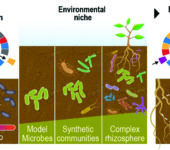
Persistence Control of Engineered Functions in Complex Soil Microbiomes
Led by Pacific Northwest National Laboratory (PNNL), the Persistence Control project uses the mechanisms of genome reduction and metabolic addiction to drive secure rhizosphere community design for robust biomass crops. This is one of several new national laboratory projects in secure biosystems design supported by BSSD.
-
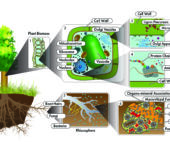
Multiscale Studies of Plant and Microbial Systems and Their Interactions
This illustration highlights the significance of understanding plant and microbial systems and their interactions across hierarchically complex levels of organization from the whole plant and tissue levels to the cellular, subcellular, and microbial community levels. Aboveground system: (1) Lignocellulosic biomass consists of heterogeneously composed stem biomass. (2) Cell growth and cell wall biosynthesis and remodeling are tightly regulated and coordinated across various subcellular compartments in response to internal and external cues. (3) The trans-Golgi network plays a central role in cell wall biosynthesis via transport of proteins (i.e., cellulose synthase complex and wall glycoproteins) and precursors (i.e., hemicellulose, pectin, and lignin) involved in wall polymer synthesis. (4) Understanding the effect of nucleotide sequence variation on protein structure and activity (i.e., sequence-function continuum) is critical for understanding and predicting functional outcomes of feedstock improvement programs based on advanced breeding or biosystems design strategies. Belowground system: (5) Plant roots and their associated microbial communities (in the rhizosphere) interact for mutual benefit. Microbial communities acquire sugars and other materials from plant roots and assist plant hosts with nutrient and water acquisition, provide pathogen defense, and mediate transformation of root tissues into soil organic matter. (6) From this plant-microbial association, soils are further developed into groups of soil particles (i.e., aggregates) that consist of plant and fungal debris; microbially derived organo-mineral associations; mycorrhizal fungal hyphae; organic matter colonized by saprophytic fungi, clay, and polysaccharides; and other pore-space chemicals.
-
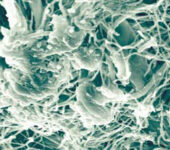
Termite Microbes
Termite hindgut microbes.
-

Terrestrial Carbon Cycle
Carbon biogeochemical cycle.
-
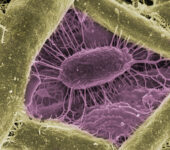
Microbes on Arabidopsis Roots
A magnified view of a microbe on Arabidopsis plant roots seemingly provides a “window” into the rhizosphere, or root zone. In fact, that’s exactly what a multi-institute research campaign is trying to frame—a view into the world of soil, roots and microorganisms. The image was obtained at EMSL, the Environmental Molecular Sciences Laboratory, a U.S. Department of Energy Office of Science national scientific user facility located at Pacific Northwest National Laboratory. The campaign includes scientists from EMSL, Pacific Northwest National Laboratory, DOE’s Joint Genome Institute, Brookhaven National Laboratory, and the Universities of Minnesota and Missouri. Funded by DOE’s Office of Biological and Environmental Research, the study examines carbon presence and distribution within the root zone, and impacts to rhizosphere microbial community diversity and functions. Results could surface climate and environmental solutions.
Research team members: Ljiljana Paša-Tolić, Charles Ansong, Heather Brewer, Alice Dohnalkova, Abigail Ferrieri, Kim Hixson, Meng Markillie, Angela Norbeck and Galya Orr of PNNL’s Earth and Biological Sciences Directorate; Susannah Green Tringe (DOE-JGI), Richard Ferrieri (BNL), Mike Sadowsky, Chanlan Chun and Christopher Staley of the University of Minnesota; and Gary Stacey, Yaya Cui and Lihui Song of the University of Missouri.
The image was captured with a Helios Nanolab dual-beam focused ion beam/scanning electron microscope at EMSL and colorized by Alice Dohnalkova.
-
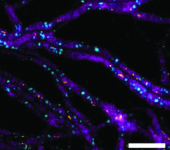
Symbiotic Interactions
Fluorescence in situ hybridization image of the endobacteria Mycoavidus sp. in the fungus Mortierella elongata. Cyan: M. elongata nuclei; magenta: M. elongata mitochondria 16S rRNA; yellow: Mycoavidus sp. 16S rRNA. Scientists use such bioimaging techniques to understand the mechanisms driving the interactions and functions of soil bacteria and fungi.